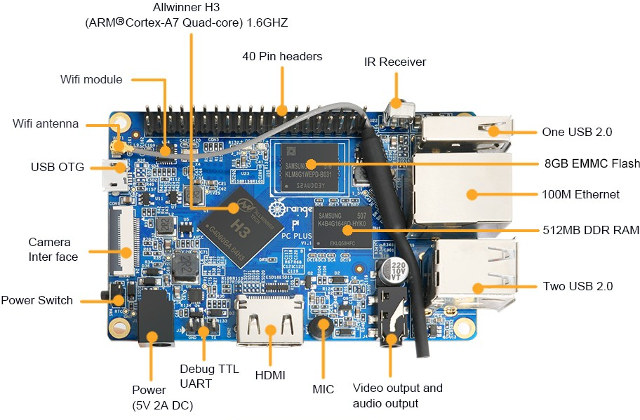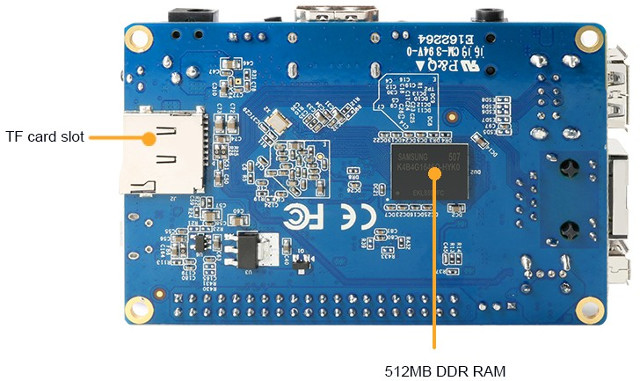Most low cost development boards do not include internal storage in order to decrease costs, and instead require their users to flash their preferred operating system on (micro) SD card. This makes it easy to get started, but many micro SD cards often suffer from poor random I/O performance, even for Class 10 or greater card, leading to a poor user experience compared to what you’d get with an eMMC flash. Shenzhen Xunlong has released yet another Allwinner H3 board, namely Orange Pi PC Plus, similar to Orange Pi PC but adding WiFi, and 8GB eMMC flash.

Orange Pi PC Plus specifications with main change with Orange Pi PC highlighted in bold:
- SoC – Allwinner H3 quad core Cortex A7 @ 1.3 GHz with ARM Mali-400MP2 GPU up to 600 MHz
- System Memory – 1GB DDR3
- Storage – 8GB eMMC flash + micro SD card slot
- Video Output – HDMI with CEC, AV port
- Audio I/O – HDMI, AV port, on-board microphone
- Connectivity – 10/100M Ethernet, 802.11 b/g/n WiFi with external antenna
- USB – 3x USB 2.0 host ports, 1x micro USB OTG port
- Camera – CSI Interface
- Expansions – 40-pin Raspberry Pi compatible header with 28 GPIOs, UART, I2C, SPI, PWM, CAN, I2S, SPDIF, LRADC, ADC, LINE-IN, FM-IN, and HP-IN
- Debugging – 3-pin UART header for serial console
- Misc – IR receiver; Power button; Power and status LEDs
- Power Supply – 5V/2A via barrel jack (micro USB OTG cannot be used to power the board).
- Dimensions – 85 x 55 mm
 As usual, the description states that the board supports “Android 4.4, Ubuntu, Debian, Raspberry Pi Image”, but most people who want to run Linux will now go with Armbian server or desktop image instead, using a Linux 3.4 legacy kernel. Mainline support for the server image is almost there for all Orange Pi H3 boards.
As usual, the description states that the board supports “Android 4.4, Ubuntu, Debian, Raspberry Pi Image”, but most people who want to run Linux will now go with Armbian server or desktop image instead, using a Linux 3.4 legacy kernel. Mainline support for the server image is almost there for all Orange Pi H3 boards.
As usual with Shenzhen Xunlong boards, the price is very competitive, and Orange Pi PC Plus is sold for $19.99 + $3.43 for shipping on Aliexpress. As a side note, while Aliexpress used to be the only options to buy a Orange Pi boards, the little inexpensive boards have become a little more popular recently, and I’ve seen several models sell on other websites such as DealExtreme, eBay, GearBest and others…

Jean-Luc started CNX Software in 2010 as a part-time endeavor, before quitting his job as a software engineering manager, and starting to write daily news, and reviews full time later in 2011.
Support CNX Software! Donate via cryptocurrencies, become a Patron on Patreon, or purchase goods on Amazon or Aliexpress




